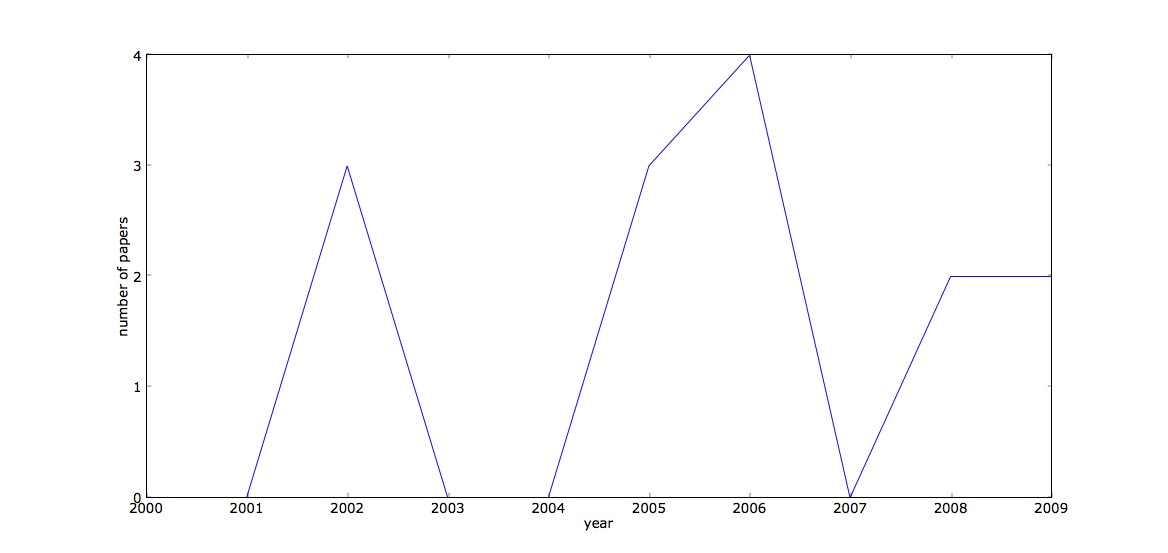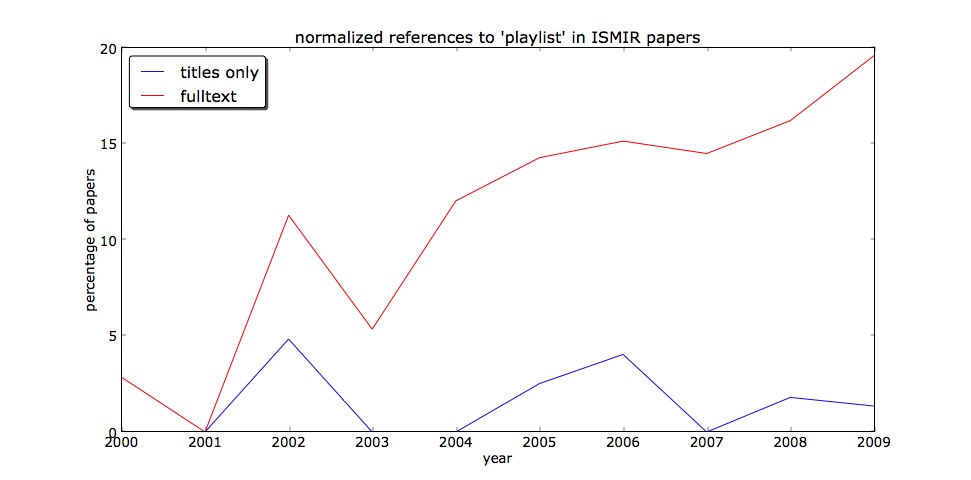Afternoon live blog for WOMRAD. Intro in first post.
Afternoon session.
1500: Industrial panel
panelists:
- Òscar Celma (BMAT, Spain), moderator
- Tom Butcher (Microsoft Bing, US)
- Mark Levy (last.fm, UK)
- Michael S. Papish (Rovi Corporation) subing for Henri-Pierre Mousset (Yozik, France)
- Gilad Shlang (Meemix, Israel)
Q (asked by OC): Do we need recommenders anymore? Are they relevant? (SFMusicTech quote about music rec only needed for people w/o friends)
TB: still valid, but personally more interested in discovery now...
ML: don't sell things, but tremendous effort in this direction, important to users, builds trust. Plus we compliment not replace social connections
MP: no need to draw lines, reinforces complimentary service idea. Many users may not need them, but perhaps that's not who these systems are for
GS: What's wrong with not having friends? Also, a tight group of friends may not have discovery, as a group. The removal of place opens more possibility to access long tail or different parts of the head. Perhaps more personalization than rec, but this a fine line
MP: the opposition of the individual v. group. If you listen to music without a community you loss the social experience.
GS: fair enough. some points about individual optimization of education. Group important, but also personal growth.
Q (asked by OC): Netflix prize. What is a good recommendation (in music)? How do we evaluate (in music)?
GS: a good rec will get people interested. wow factor. acknowledge you and surprise you at same time. music is short , which makes it easier to tune a rec profile. sharing implies liking, that's useful. tagging; more tags=more popular
(...small aside...)
ML: we run controlled experiments. quietly divide users to test different methods. Netflix fails in that it evaluates with data that's already been seen not new data.
MP: good rec means different things at different times. gives an example of a good rec that is not interesting: an artist you've previously bought releases a new album. not interesting but good. this would be bad for radio.
TB: in industry there are many ways to test. more purchase is different than more enjoyment.
ML: we at last would love for some theory to be developed for rec based on user logs.
OC: more data please
ML: you can always ask...
(this goes back and forth)
MP: yet there will never be good data. sparse data is hard, but makes your a better human (eat your green)
Q (OC) discuss user interfaces, user exerience etc. :
TB: pandora is a winner, don't ignore the interaction
ML: thesixtyone is great. interface v. playful good long tail, would love for a last.fm interaction, but discussing issues
MP: name checks Paul lamere, who he cites saying thesixtyone is an exotic rec, but MP thinks this is the way people normally use music, we should work to have systems that act like this. Need a toolbelt not one ubiquitous tool
GS:we tackle similar things. in B2B you need systems that complete clients' existing systems. If you over rec, you can scare people off, social dynamics
MP: think about the inverse rec - what should you not rec? Also from a UX stand point, to build trust, change recs over time. General to personal as a user interacts with a system
GS: different recs can be very personal
ML: last.fm takes a sort of opposite
-crosstalk-
MP: this is possible from last.fm's transparency
Q (OC) What do you want solved?
TB: we're hiring. Also, algorithms must scale or they're scalable
ML: how to merged datasources? how to use human-to-human recs
MP: see my keynote, exploit user psych, What are good Qs to ask users to build profiles
GS: more info for recs, params in audiofiles. map user params to extractable params Moving techniques to non-western musics. What about china and india? We should be serve them.
MP: is the sonic data really the key? I don't think so, too much effort in this direction sim is different than rec
GS: but sim is a good start
Q(OC) Do you use content-based features (y/n please)? ISMIR fun, glass ceiling, do you follow this work in academics, do you think it's solved?
GS: Yes. see last discussion core to our business, vital to start a relationship, move to social and such over time.
OC: what sorts of things do you use
GS: of things. 10 (does not list). aggressiveness very important.
ML: I come from the MIR community. we do content-based ID, have tried to intro content-based stuff and it's never been successful. But our hearts are in it. We have enough users that cold start doesn't matter. auto-tagging would be sweet though for the holes in our social data (musicological tags for instance). maybe youtube
TB: yes for the most part to ML's comments. content-based is too costly, tags and metadata are super effective
GS: what about the new company, that doesn't have lots of data. is you're just getting into the game. these people need results. can't tell them go gather data for a year and we'll sort it out
MP: item to item is very different than personalized
ML: check that P2P paper from ismir
Hannah from Franhauffer: we have clients (like film producers) no data,what then?
MP: exactly.
(Eugenio Tacchini): GS is the DNA all of it? really?
GS: no, not really. music DNA for rich space, but still need personalized info
Q (OC) if you were to hire a researcher (aside: research cannot program) what kind skills do you want (not resume skills, fancy skills)?
TB: domain experience, audio music, computer vision, breadth better than depth. production coding skill in some language
ML: we're hiring as well. If you don't want to code, probably won't work. CS skills really important. Big database skills. hadoop win. strong C++ and research also python. data and viz as well.
MP: we are hiring as well. growing r & d group. we have offices all over. we like building things. though we have room for research. we like solving problems. again broad. can you pivot. don't need a PhD to be useful.
GS: we're also hiring (that's 4 for 4) we're a start up. data analysis and mining. core CS + creative skills, willing to sweat.
OC: perhaps also adoptability
GS: yes. you're there to invent. plus we're in Tel Aviv and that's sweet
Q (claudio): What is the relationship your company has with musicians are they just a commodity?
OC: our missing speaker (Henri) does this
GS: I spoke with him, he thinks: for young musicians it's hard to reach your audience.
OC: BMAT does this with jamendo. when they type in 'Michael Jackson' what do you do?
MP: but don't sell recsys as a way to push new artists only. In a certain context, ie. neg search, but careful. Don't exploit users or artists
GS: but the state of the art pushes new bits
(from audience) What about piracy?
GS: it's not good.
TB: there are 2 view points: piracy increases consumption. otherside: do we now that?
OC: now we're over time sorry.
---
in light of the near transcript I just typed, I'm starting a new post for the afternoon talks.
Updated (5:33) : corrected questioner ID



 is the cost to add song m to list after song n,
is the cost to add song m to list after song n,  is some measure of distance from song n to song m and
is some measure of distance from song n to song m and  is the same measure of distance from song m to song e. Song e is the end song for the whole playlist. So basically the idea is that the cost of moving to a node is a ratio of how far away it is from where you were to how far it is to where you're trying to get. The whole thing is reversed for the other half, so the cost function makes it cheap to move toward the start song. If you simply want to randomly traverse social links the cost can be set to an arbitrary equal value (I used 1) for all links.
is the same measure of distance from song m to song e. Song e is the end song for the whole playlist. So basically the idea is that the cost of moving to a node is a ratio of how far away it is from where you were to how far it is to where you're trying to get. The whole thing is reversed for the other half, so the cost function makes it cheap to move toward the start song. If you simply want to randomly traverse social links the cost can be set to an arbitrary equal value (I used 1) for all links.




